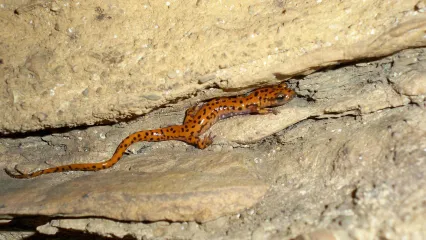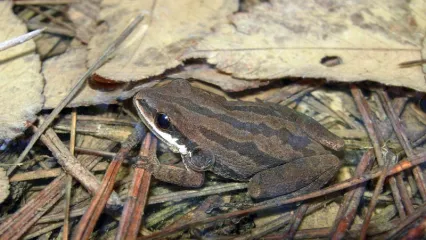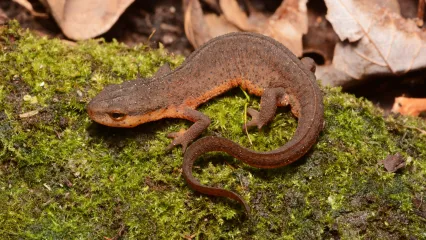
Description
Cave salamanders are moderately small, thin-bodied salamanders with broad heads, large eyes, and relatively long legs. The background color is red, orange, or orange-yellow, and the body, tail, and legs are spotted with black. Additionally, the relatively large head is flattened and the eyes protrude well above the head. The underside of the body is lighter in color, often a pale red or orange, but occasionally nearly white with no markings The thin tail is 60 to 70 percent as long as the body and round in cross section. Cave salamanders have 13 – 14 costal grooves.
The dark-sided salamander is similar in appearance to the cave salamander, but has a longer tail and a series of black markings extending down the lateral surfaces.
Size
Cave salamanders are medium-sized salamanders. Individuals can reach up to 7 inches in total length but most are between 4 and 6 inches.
Habitat
Cave salamanders are restricted to the Ozark Plateau and Ozark foothills in Oklahoma reaching the Arkansas River at Camp Gruber. Their west to east distribution extends from northeastern Oklahoma almost to south-central Pennsylvania and north to south from southern Indiana to central Alabama. In general, the distribution follows a band of fractured limestone outcrops and limestone caves across the central-eastern United States.
Life Cycle
Although cave salamanders can be found in the twilight regions of limestone caves, they are by no means restricted to those areas. They are common in limestone outcrops and on hillsides below limestone outcrops. During the day they seek refuge under rocks and in crevices in fractured limestone. At night they are active on the surface, but usually remain close to crevices.
Breeding occurs during summer and eggs are deposited from September through October, and possibly later. Females deposit clutches of 50 – 120 tiny eggs in pools of water in limestone caves and deep crevices containing water. The aquatic larvae grow and develop slowly, largely because breeding pools contain very little food and the water temperatures are relatively low. These pools also contain few predators. Larvae metamorphose when they reach a little more than one inch in length. Larvae feed on tiny invertebrates in the pools in which they live while adults feed on small insects and other arthropods.
How To Observe
Cave salamanders can be found relatively easily by turning limestone rocks in and below limestone outcrops, especially in spring when it is relatively wet. They are much easier to find at night by searching along crevices in limestone outcrops with a good headlight.
(This profile was created by Dr. Laurie Vitt as part of a partnership between the Wildlife Department and the Sam Noble Oklahoma Museum of Natural History. It was funded as part of a larger State Wildlife Grant to survey and inventory amphibians and reptiles of the Wildlife Management Areas of Oklahoma: T-35-P-1.)

